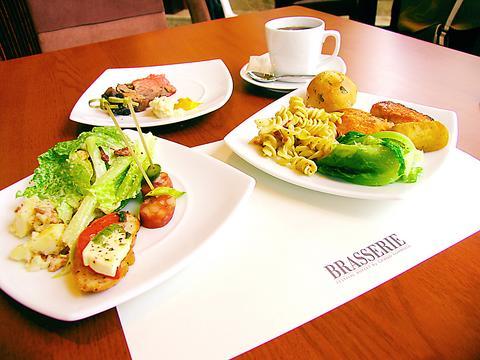Asian buffets are something altogether different from their American cousins I grew up eating at. In the Midwest, we have chain-store buffets with giant conveyor belts piled with food. They resemble airport luggage claims retooled to serve obscene amounts of fried chicken, mashed potatoes, green bean casseroles and, of course, fruit-filled Jello molds topped with marshmallow cream. Comparing them with the buffets you'll find in Asia's cosmopolitan capitals is enough to give you indigestion decades after eating at one.
Grand Formosa Regent's Brasserie restaurant has the "Festival Buffet" and it's appropriate because it turns breakfast, lunch and dinner into an active affair. Instead of waiting patiently as your order comes to you, you're swept into an elegant serving area to explore what lies behind the lines of people at each of the several areas of interest.

PHOTO: DAVID MOMPHARD, TAIPEI TIMES
A large circular area to one side is teeming with a small ocean of seafood. Red snapper, tuna, eel, shrimp and crabs are among the items you'll usually find here, but those items change with each catch of the day. The succulent tuna sashimi you had there on your last visit might be replaced with salmon sushi. Such are life's travails.
Heartier fare can be found across the room, where pastas, potatoes and a cornucopia of Continental cuisine sits steaming. It's here that meat-lovers will meet a man in a tall white hat who they'll undoubtedly visit again and again. He's slicing the best roast beef this side of town from Lawry's. I say "best" because it's cooked to medium rare perfection and because they haven't forgotten the fixings: spicy Dijon mustard and uncut horseradish, the kind to clear your sinuses when slathered on.
The roast beef alone is nearly worth the price of admission, but don't fill up on it alone or you'll miss some of the items that separate Brasserie from (excuse me) the smorgasbord of buffets. First is the hot pot area; a giant cauldron kept boiling with all your favorite hot pot fare. The only thing missing is the mix-it-yourself sauces -- soy, garlic, basil, chives, peanut powder, sugar, vinegar and the like.
One suggestion to the Grand Formosa would be to include more signage above each of the areas so that diners needn't line up just to see what's behind the row of people curtaining of the cuisine. It would keep folks from milling about in the middle of the room and, if done tastefully, wouldn't detract from the decor. Brasserie has a long way to go before it looks anything like an airport luggage claim.

In the March 9 edition of the Taipei Times a piece by Ninon Godefroy ran with the headine “The quiet, gentle rhythm of Taiwan.” It started with the line “Taiwan is a small, humble place. There is no Eiffel Tower, no pyramids — no singular attraction that draws the world’s attention.” I laughed out loud at that. This was out of no disrespect for the author or the piece, which made some interesting analogies and good points about how both Din Tai Fung’s and Taiwan Semiconductor Manufacturing Co’s (TSMC, 台積電) meticulous attention to detail and quality are not quite up to

April 21 to April 27 Hsieh Er’s (謝娥) political fortunes were rising fast after she got out of jail and joined the Chinese Nationalist Party (KMT) in December 1945. Not only did she hold key positions in various committees, she was elected the only woman on the Taipei City Council and headed to Nanjing in 1946 as the sole Taiwanese female representative to the National Constituent Assembly. With the support of first lady Soong May-ling (宋美齡), she started the Taipei Women’s Association and Taiwan Provincial Women’s Association, where she

It is one of the more remarkable facts of Taiwan history that it was never occupied or claimed by any of the numerous kingdoms of southern China — Han or otherwise — that lay just across the water from it. None of their brilliant ministers ever discovered that Taiwan was a “core interest” of the state whose annexation was “inevitable.” As Paul Kua notes in an excellent monograph laying out how the Portuguese gave Taiwan the name “Formosa,” the first Europeans to express an interest in occupying Taiwan were the Spanish. Tonio Andrade in his seminal work, How Taiwan Became Chinese,

Mongolian influencer Anudari Daarya looks effortlessly glamorous and carefree in her social media posts — but the classically trained pianist’s road to acceptance as a transgender artist has been anything but easy. She is one of a growing number of Mongolian LGBTQ youth challenging stereotypes and fighting for acceptance through media representation in the socially conservative country. LGBTQ Mongolians often hide their identities from their employers and colleagues for fear of discrimination, with a survey by the non-profit LGBT Centre Mongolia showing that only 20 percent of people felt comfortable coming out at work. Daarya, 25, said she has faced discrimination since she